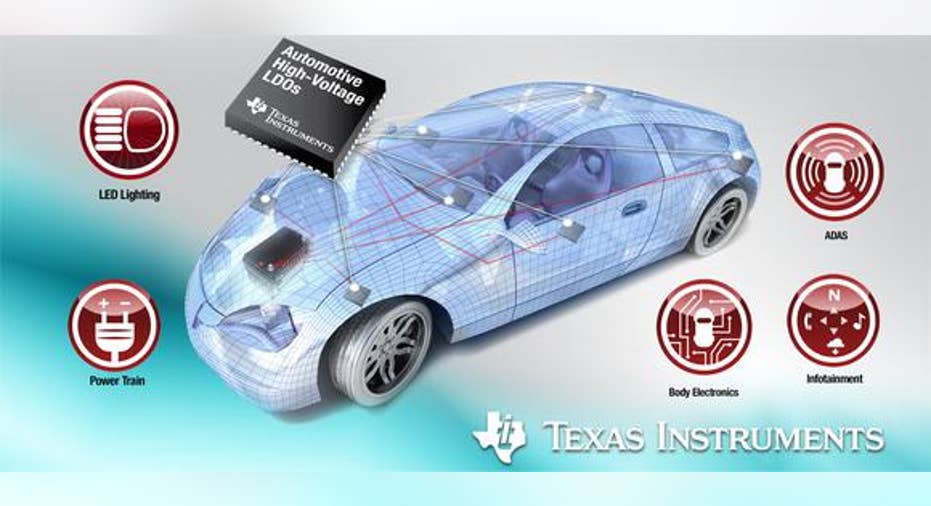Better Buy: Intel Corporation or Texas Instruments Incorporated?

Intel and Texas Instruments are both well established chipmakers, but they generally aren't considered competitors. Intel mainly manufactures x86 chips for PCs and data centers, while TI produces analog and embedded chips for mobile devices, electronics, cars, industrial machinery, and wireless infrastructure.
However, investors looking to add a major chipmaker to their portfolios might be unsure which company is a better long-term bet. Let's take a look at both companies' strengths, weaknesses, and valuations to decide.
An Intel-powered data center. Source: Intel.
Comparing strengthsIntel constantly highlights its data center, Internet of Things (IoT), and non-volatile memory businesses as its three pillars of growth, which generated nearly 40% of its sales last year. Data center sales accounted for 77% of that total. During the year, Intel's IoT revenue rose 7% annually, data center sales improved 11%, and "all other" revenue -- which includes memory sales -- grew20%.
Intel's strength in data centers is supported by its 99% share of the worldwide server market. In the IoT market, which Intel uses to tether devices to data centers, Intel launched low-power modules like Curie and Edison for wearable and smart devices. In the memory market, Intel believes that 3D XPoint, the industry's first new memory technology in over two decades, will boost sales over the next few years. Those three businesses accounted for over 60% of Intel's operating margin last year.
Texas Instruments breaks its business down into six main categories -- industrial, automotive, personal electronics, communications systems, enterprise systems, and "other" products. During last quarter's conference call (as transcribed by Thomson Reuters), TI declared that its growth in the industrial and automotive segments, which accounted for 46% of its 2015 sales, will generate "stickier revenue and margin profiles over time." TI also switched from 200mm to 300mm wafers for manufacturing, which reduced chip production costs by 40%. As a result, TI's gross margin rose to a record high of 58.5% last quarter, and its free cash flow improved 6% annually to $3.7 billion for the year. By comparison,Intel's free cash flow slipped 2% over the past 12 months, due to investments in R&D and its $16.7 billion purchase of Altera.
Source: Texas Instruments
Contrasting weaknessesIntel faces three main problems: PC sales remain sluggish, its mobile business is still unprofitable, and its data center growth is disappointing. Last year, Intel's Client Computing (PC and mobile) sales fell 8% and accounted for 58% of its top line. That drop caused Intel's total revenue to fall 1% for the year. Intel's 11% growth in data center sales also missed its prior forecast for 15% annual growth through 2018. Meanwhile, Qualcomm's interest in selling ARM -based server chips could threaten Intel's near-monopoly in data centers.
TI also has three big weaknesses: its exposure to Apple , questions about industrial growth, and sluggish spending on wireless infrastructure. Apple orders accounted for11% of TI's sales last year, so slowing sales of iPhones could hurt its top line growth. For the current quarter, RBC Capital analyst Amit Daryanani expects TI's "Apple-centric revenue" to decline about 30% annually. Economic slowdowns worldwide could also cause TI's industrial revenue, which was "about even" in 2015, to fall in 2016. Lastly, many major telcos are focusing on expanding their digital ecosystems instead of upgrading their cell towers. As a result, TI's communications revenue -- which accounted for 13% of its sales last year -- could keep slipping this year.
Source: Apple.
Forecasts, valuations, and dividendsLooking ahead, analysts expect Intel and TI to both grow their annual earnings by 10% over the next five years. That gives Intel and TI respective 5-year PEG ratios of 1.3 and 2. Neither ratio has fallen below the "undervalued" threshold of 1 yet, but Intel certainly looks cheaper compared to its earnings growth potential.
Over the past 12 months, Intel spent 39% of its FCF on dividends and 22% on buybacks. During that same period, TI spent 39% of its FCF on dividends and 62% on buybacks. While that might make TI look more "generous" than Intel, returning over 100% of its FCF to shareholders doesn't leave much room for big dividend hikes or strategic acquisitions. Intel's forward annual dividend yield of 3.3% is also still higher than TI's 2.7% yield.
The winner: IntelTexas Instruments is a solid, well-diversified chipmaking play, but I think Intel's lower valuations, higher dividends, and shrewder use of its free cash flow make it a better long-term play. Nonetheless, investors should do their due diligence and see which chipmaker is best suited for their investing goals.
The article Better Buy: Intel Corporation or Texas Instruments Incorporated? originally appeared on Fool.com.
Leo Sun owns shares of Qualcomm. The Motley Fool owns shares of and recommends Apple and Qualcomm. The Motley Fool recommends Intel. Try any of our Foolish newsletter services free for 30 days. We Fools may not all hold the same opinions, but we all believe that considering a diverse range of insights makes us better investors. The Motley Fool has a disclosure policy.
Copyright 1995 - 2016 The Motley Fool, LLC. All rights reserved. The Motley Fool has a disclosure policy.



















